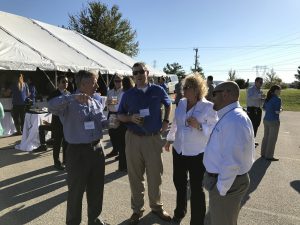Arraya Insights Radio
Episode 2: Ignite of the Living Dead: Recapping Microsoft’s ‘Every Tech Event’
Host: Thomas York (Director, Quality and Operational Excellence)
Guests: Matt Sekol (Director, Microsoft and Cloud Practice) and Jason Kline (Microsoft Cloud Solutions Architect)
With Microsoft Ignite in the rearview, the Arraya Insights Radio crew recaps the biggest stories coming out of this year’s conference, including the future of Skype for Business/Teams and Microsoft’s growing competitive-friendships with its fellow industry leaders. Also, they don their reading glasses to assess Satya Nadella’s new book, “Hit Refresh: The Quest to Rediscover Microsoft’s Soul and Imagine a Better Future for Everyone.”
Theme Music: “I Don’t Remember (Yesterday)” by Hygh Risque
Further Reading:
- Microsoft Ignite: Demystifying the Future of Skype for Business, by Arraya Insights
- Tech Leaders Band Together Around Microsoft Ignite: 8 Takeaways, by Arraya Insights
- Don’t Treat Office 365 Like A Gym Membership, by Matt Sekol
- Should Azure Stack Be On Your Radar? 5 Use Cases, by Arraya Insights
- Remove the Fog of Unknown Cloud Applications, by Jason Kline
Want to learn more about what took place at Microsoft Ignite? Click HERE to register for Arraya’s upcoming Microsoft Ignite Recap. This event will take place on Nov. 9 at The Hub in Conshohocken, PA and will feature sessions covering the latest news on Azure, Office 365, Hybrid Cloud, and more!
 statement, the Department of Homeland Security and the Federal Bureau of Investigation warned of “advanced persistent threats” targeting the nation’s critical infrastructure, including companies in the energy, manufacturing, nuclear, aviation, and water industries. The warning also included a look at the tactics employed by attackers as well as a rundown of
statement, the Department of Homeland Security and the Federal Bureau of Investigation warned of “advanced persistent threats” targeting the nation’s critical infrastructure, including companies in the energy, manufacturing, nuclear, aviation, and water industries. The warning also included a look at the tactics employed by attackers as well as a rundown of  announcements from Microsoft, including a look at what
announcements from Microsoft, including a look at what  food and better conversations. This annual tradition has grown steadily over the company’s history, with this year’s event featuring our largest crowd yet. That notion of growth and evolution is something that was palpable throughout the day.
food and better conversations. This annual tradition has grown steadily over the company’s history, with this year’s event featuring our largest crowd yet. That notion of growth and evolution is something that was palpable throughout the day. Another first for the Open House was a reimagined, visually oriented cyber security survey. While surveys themselves certainly aren’t unheard of at Arraya events, the execution of this one was unique. At check-in, attendees were given a ping-pong ball marked with a number and asked to drop it in the tube marked with the security issue they struggle with most. One number was then randomly drawn from those who participated in the survey, with the winner receiving a pair of tickets to an upcoming Philadelphia 76ers game. The results of the survey will be published in a future blog; however, the drawing winner was Chris Kohl, Vice President & CIO of Vertex, Inc.
Another first for the Open House was a reimagined, visually oriented cyber security survey. While surveys themselves certainly aren’t unheard of at Arraya events, the execution of this one was unique. At check-in, attendees were given a ping-pong ball marked with a number and asked to drop it in the tube marked with the security issue they struggle with most. One number was then randomly drawn from those who participated in the survey, with the winner receiving a pair of tickets to an upcoming Philadelphia 76ers game. The results of the survey will be published in a future blog; however, the drawing winner was Chris Kohl, Vice President & CIO of Vertex, Inc. blog post, entitled “
blog post, entitled “ complicated. Of course, whenever an organization’s technology side is on par with its business team, success is almost certain to follow.
complicated. Of course, whenever an organization’s technology side is on par with its business team, success is almost certain to follow. after the September the business world just had, it might be hard to notice much of a difference. Even setting aside the near history-making cyber disaster that is still going on at Equifax – something Arraya’s resident security expert Tom Clerici
after the September the business world just had, it might be hard to notice much of a difference. Even setting aside the near history-making cyber disaster that is still going on at Equifax – something Arraya’s resident security expert Tom Clerici  years, we’ve developed a long enough list of services that it can be easy to miss one or two of the ways we provide value.
years, we’ve developed a long enough list of services that it can be easy to miss one or two of the ways we provide value. back on my own conference experiences and, while blogs can bring the energy (if the author conveys it well enough), there are few things like being in the room when a major technology advancement or a game-changing solution is announced. I love the adrenaline of those moments and I also love sharing them with customers. One of the great things about conferences is that they let companies like Arraya spend quality time with our customers. We can experience the future of technology together and brainstorm, in real time, how to use these advances to solve business challenges.
back on my own conference experiences and, while blogs can bring the energy (if the author conveys it well enough), there are few things like being in the room when a major technology advancement or a game-changing solution is announced. I love the adrenaline of those moments and I also love sharing them with customers. One of the great things about conferences is that they let companies like Arraya spend quality time with our customers. We can experience the future of technology together and brainstorm, in real time, how to use these advances to solve business challenges. Cloud services have eroded our previously well-defined network edge. Due to these changes, an intelligent network must now be leveraged to provide insight to organizations and security to its users.
Cloud services have eroded our previously well-defined network edge. Due to these changes, an intelligent network must now be leveraged to provide insight to organizations and security to its users.